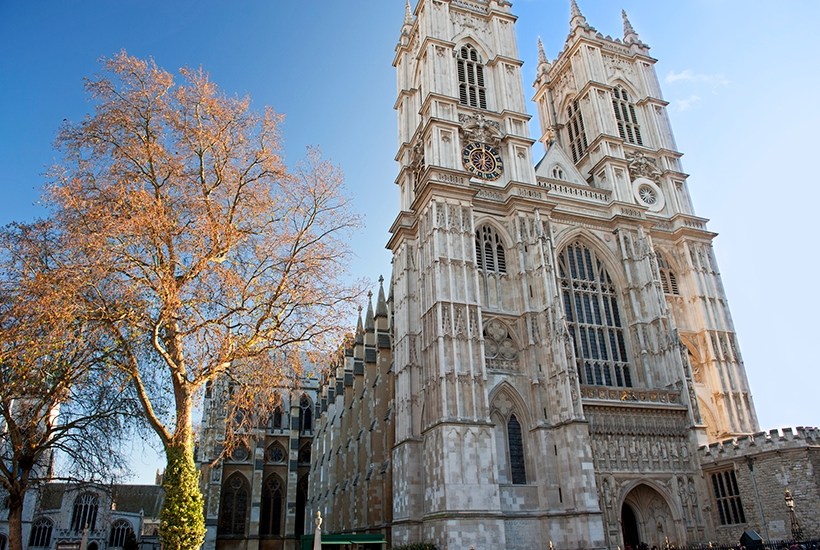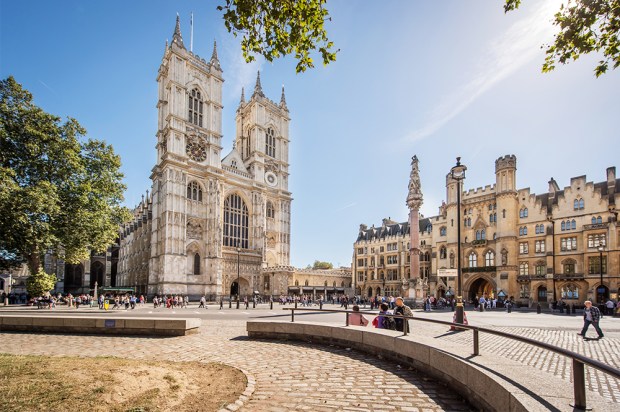It took me several weeks, after returning to the Spectator office, to work out what was missing. It wasn’t the people — though Westminster is a zombie town these days, and even Pret A Manger, once hectic as a trading floor, is calm. I like the calm. What’s missing, I realised as I walked past Westminster Abbey, is the bells.
If you’re anywhere near the Abbey when the bells start up, it’s like being caught out in a monsoon. It’s overwhelming and joyful. You can’t speak. You can’t think. There’s nothing for it but to stop and gawp up like a guppy at feeding time. The bells have been silent since March, since the Church of England abandoned its churches, and it’s strange how claustrophobic it feels without them.
Half a mile away, over the river in Lambeth Palace, sits our tortured Archbishop of Canterbury. A fortnight ago he suggested that we were all suffering from ‘a sort of national PTSD’ brought on by uncertainty. Well then, here’s a suggestion for the Archbishop. Instead of depressing the country by diagnosing it as nuts, why not cheer it up? Instead of agonising over which statues to rip out of which churches, why not encourage the bells to ring? Especially the Abbey bells. Every cathedral and church with willing ringers and a decent belfry should be given some special archbishop’s award for cracking on despite the virus. I can’t think of a better remedy for national PTSD.
I’m not for a minute suggesting any ringers risk their lives. I’m a Covid-believer and I think it was reasonable to be cautious back in March. But the C of E, not known for laughing in the face of risk assessment, has said that it ‘would be good to get ringing going’. Ringing has been allowed since July and there are careful guidelines in place — social distancing and masks.
More to the point, churches around the country have started up again: St Michael’s Church in Bishop’s Stortford, Otley Parish Church, St John the Baptist in Beeston… some have moved ringers on to different levels so they can be distanced, Nantwich has inserted timber struts between the walls to allow a rope to be drawn into a new position, Holy Trinity Church in Stratford-upon-Avon has started using an apparatus called an Ellacombe which allows all the bells to be rung by just one man. St Paul’s Cathedral is ringing, so why not Canterbury Cathedral, the Mother Church of the worldwide Anglican Communion? Why not Westminster Abbey, which should be marking feast days and royal birthdays, helping order the awful sprawl of Covid life? There are families of ringers rising to the challenge, I’ve heard, because people in the same bubble can ring adjacent bells; there are even ringers who can handle two ropes at a time — surely now is their moment.
Everything about bellringing is an antidote to terrible 2020. It’s not done these days to be patriotic or feel proud of British history, but you’d have to have the spirit of a slug not to admire our way with bells. For 5,000 years or so humans rung hand bells or swung them through an arc. Then sometime in the 1600s a Brit thought to invent a way of turning bells in a full circle, leaving the bell balanced upside down. This meant precision ringing was possible, and that bells could be rung in a sequence, and that this sequence could be changed — hence ringing the changes, and the strange mathematical tumbling peal that’s the soundtrack of English life.
The rules that generate the different changes are called ‘methods’, and even reading the list of methods is soothing: Black Cat Delight Royal, Grandsire Caters, Chartres Delight Royal, Percy’s Tea Strainer Treble Place Major… there are special methods rung for feast days and royal birthdays, except not this year. Westminster Abbey was silent for the Queen’s birthday, though York Minster rang for the death of Gerald, its cat.
Back in 2016 I was invited to visit a bell tower. One dark wet night, about this time of year, I knocked at the door of St Vedast opposite St Paul’s Cathedral. My notes from the time say it was like a straight replay of The Rocky Horror Picture Show. The door creaked open and a gaunt, strange-looking man said: ‘Hello. You’re wet. I think you’d better… come inside.’ Up we went to the ringing chamber where I discovered that the inner workings of a ring of bells is just as eerie and impressive as its sound. Because the bells are in a separate chamber above, what you see when you enter the ringing room is simply a circle of men and women facing each other, staring intently as if attempting telepathy, counting, feeling their way into the changes. I remember how the fluffy ‘sallies’ shot up, wriggling through the holes in the ceiling, and how addictive it is to handle a bell: the great weight, the precarious balance. It’s strange the way your mind starts communing with a ton of metal hanging unseen in the dark above, and it’s odd how proprietorial I felt, as if I had charge of a living thing.
Among themselves, ringers refer to their art as ‘The Exercise’. How excellent is that? Recently, Catherine Pepinster at the Telegraphurged young people to keep the art alive. I would have thought it was a natural choice for the Harry Potter generation.
Ringers who’ve begun ringing again, in a limited way, have talked about how joyful they feel to be back in the belfry. Even though the masks are suffocating, even though the bells can only ring in 15-minute bursts, it feels important to them to do it. Jane Deadman, head bellringer at Chichester Cathedral, says: ‘We won’t be able to ring all eight bells, it won’t be all the ringers, but it will be enough for ringing to be part of the cathedral services, and to remind people which day is Sunday.’
Will Westminster Abbey ring for All Souls Day? Will it ring for Remembrance Day? This year, of all years, we need the bells back.
Got something to add? Join the discussion and comment below.
Get 10 issues for just $10
Subscribe to The Spectator Australia today for the next 10 magazine issues, plus full online access, for just $10.
You might disagree with half of it, but you’ll enjoy reading all of it. Try your first month for free, then just $2 a week for the remainder of your first year.















Comments
Don't miss out
Join the conversation with other Spectator Australia readers. Subscribe to leave a comment.
SUBSCRIBEAlready a subscriber? Log in